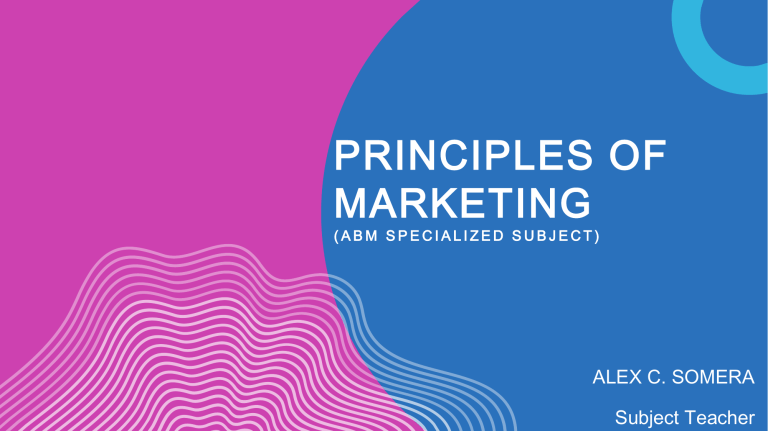
PRINCIPLES OF MARKETING (ABM SPECIALIZED SUBJECT) ALEX C. SOMERA Subject Teacher UNDERSTANDING CULTURE, SOCIETY AND POLITICS Citius, Altius, Fortius UNDERSTANDING CULTURE, SOCIETY AND POLITICS Citius, Altius, Fortius UNDERSTANDING CULTURE, SOCIETY AND POLITICS Citius, Altius, Fortius UNDERSTANDING CULTURE, SOCIETY AND POLITICS Citius, Altius, Fortius UNDERSTANDING CULTURE, SOCIETY AND POLITICS Citius, Altius, Fortius • the management process responsible for identifying, anticipating, and satisfying customer requirements profitably. (Chartered Institute of Marketing) MARKETING MARKETING https://www.ama.org/the-definition-of-marketing-whatismarketing/#:~:text=Marketing%20is%20the%20activity%2C%20set,Approved%202017) ➢ Coming up with a product and defining its features and benefits ➢ Setting its price ➢ Identifying its target market ➢ Making potential customers aware of it ➢ Getting people to buy it ➢ Delivering it to people who buy it ➢ Managing relationships with customers after it has been delivered MARKETING IS ABOUT Think about a typical business- a restaurant, for example. It’s easy to see how the person decides what products (menu) to offer involves marketing: selecting the products to be sold and its price. It’s even easier to see how the person who puts ads in the social media or papers works in marketing: they are in charge of advertising—making people aware of the product and buying it. But what about the security guard, servers, the order takers, and the person behind the counter and kitchen? What about the projectionist? Are they marketing the business? MARKETING Principles of Marketing MARKETING AS AN ART OF EXCHANGE THE EXCHANGE INVOLVES: THE EXCHANGE INVOLVES: 1. 2. 3. 4. 5. 6. 7. 8. The Customer Needs Wants Demand The Product The Provider (or Seller) The Transaction The Exchange Process THE EXCHANGE INVOLVES: THE CUSTOMER A person or organization with a want or need willing to give money or other personal resources to address this need. NEEDS customer’s desire for the products or services specific benefits required by a human being for his body and mind's health and well-being. WANTS the desire for products or services that are not necessary, but which consumers wish for. DEMAND describes a consumer’s desire, willingness, and ability to pay the price for a specific good or service. PRODUCT physical good, a service, experience, or idea designed to fill the customer’s want or need THE PROVIDER/SELLER the company or organization offering a need-satisfying thing, which may be a product, service, experience, or idea THE TRANSACTION the terms around which both parties agree to trade value-forvalue (most often, money for the product) EXCHANGE PROCESS when an individual or an organization decides to satisfy a need or want by offering some money or goods or services in exchange. PARTICULARS NEEDS HUNGER FASHION WEAR INFECTION SHELTER THIRST TRANSPORTATIO N SCOPE OF MARKETING WANTS EXCHANGE 1. 2. 3. an act of giving one thing and receiving another in return. What can you recall about the definition of exchange? Why is exchange an important factor in the business world? Give at least one example of an exchange? Principles of Marketing SCOPE OF MARKETING SCOPE OF MARKETING SCOPE OF MARKETING SCOPE OF MARKETING Tourist Destinations Five Star Hotel Services Enchanted Kingdom Rapelling/Rock Climbing Zipline Surfing Paragliding Snorkeling Concerts Sports Events SCOPE OF MARKETING SCOPE OF MARKETING SCOPE OF MARKETING SCOPE OF MARKETING SCOPE OF MARKETING SCOPE OF MARKETING SCOPE OF MARKETING ➢ Capturing the attention of your target market ➢ Persuading a consumer to purchase your product ➢ Providing the customer with a specific, low-risk action that is easy to take PRIMARY PURPOSE OF MARKETING If a business's objective is to sell more products or services, marketing helps you achieve that goal. PRIMARY PURPOSE OF MARKETING 1. 2. 3. 4. 5. 6. 7. 8. Identify Customer Satisfy Customer Retain Customer Creation of Products and Services Distribution Pricing Promotion Selling ROLE OF MARKETING The business or organization must understand customer wants, demands, and needs. They also need to identify the target market (to whom they would sell their products and services) and how to reach them. IDENTIFY CUSTOMER Make the right products or services available to the right people at the right time. Make everyone feel better off from the exchange. SATISFY CUSTOMERS Give customers a reason to keep coming back. Find new opportunities to win them. RETAIN CUSTOMERS Anything the company offers for sale to the buyers to satisfy their demands, wants, and needs. CREATION OF PRODUCTS AND SERVICES It entails how a company is going to deliver its products and services to their respective customers. DISTRIBUTION Make sure you’re not losing any profits by selling too low. However, you don’t want to overcharge and then not see any return because customers found a cheaper alternative. PRICING It involves confirming an advertisement is seen in the right places by the right people. PROMOTION The selling process begins once you’ve completed market research and determined what your prospects want and need. SELLING A dream, after all, is just a dream. A goal, in contrast, is a dream with a plan and a deadline. The marketing goal is a specific, measurable, attainable, realistic, and timebound metric (SMART) that drives every marketing effort. MARKETING GOAL Relationship between vision and goals A vision is what you want your business to look like some time in the future. When clearly defined, a vision becomes a beacon that inspires, gives you direction, and keeps you on course. Having a clear vision allows you to create marketing goals that move you closer to your ideal future. If you find that you have goals that you never achieve, the issue may not be the goal. The issue may be that the goal isn’t aligned with your vision. VISION AND GOALS For example, if your vision is to: ➢ Grow your business into a 3 million company with 30 employees; then, your goals need to align with what you should do to achieve that growth. ➢ Build a lifestyle business that offers select services to small business owners; then, your goals will be congruent with staying independent. VISION AND GOALS ➢ Identify how much revenue you need to generate from your inbound marketing efforts ➢ Determine how many sales you need to hit those revenue goals ➢ Identify your closing rate and how many opportunities you need ➢ Implement your other critical business goals ➢ Set quarterly benchmarks DEVELOPING MARKETING GOALS MARKETING MIX IDENTIFY CUSTOMER IDENTIFY CUSTOMER IDENTIFY CUSTOMER IDENTIFY CUSTOMER IDENTIFY CUSTOMER IDENTIFY CUSTOMER IDENTIFY CUSTOMER





